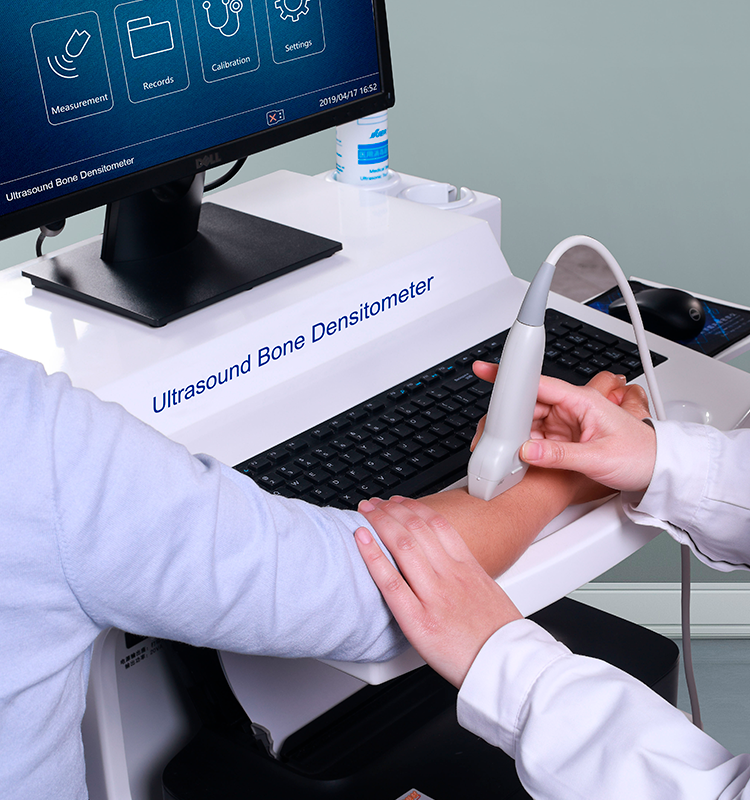

From: Pinyuan Medical AddDate: 2019-6-25Views: 1376
Comparison of healthy bone and bone with osteoporosis
Bone density starts to gradually decrease once you turn 30, even if you do not have osteoporosis. Around the age of 50 this process speeds up, especially in women. Before
menopause, the female sex hormone estrogen helps protect the bones by slowing down bone loss. So after menopause, when this hormone level drops, bone tissue is lost more
quickly. If no cause for the bone loss can be found, it is called primary osteoporosis. Secondary osteoporosis is when bones have become fragile due to something else, like another
condition or long-term corticosteroid use.
Risk factors
There are a number of factors that can increase someone's risk of developing osteoporosis. Some can be influenced, whereas others cannot. The main risk factors for
osteoporosis include:
Age: As we get older, our bone density decreases and the risk of developing osteoporosis increases. Men over the age of 65 and post-menopausal women are at the greatest risk.
Sex: Women develop osteoporosis more often than men, and they are also more likely to have bone fractures.
Low body weight (compared to body size)
Diet low in calcium
Vitamin D deficiency
Lack of exercise
Family history: Women whose mother or father broke their hip because of osteoporosis are at greater risk of developing osteoporosis themselves.
Smoking
Drinking a lot of alcohol
Long-term steroid use
Use of other medications, such as some antidepressants (SSRIs) or diabetes medicines (glitazones)
Conditions such as rheumatoid arthritis or hyperthyroidism (an overactive thyroid gland)

Prevalence
According to the Robert Koch Institute, 8% of men and 13% of women in Germany between the ages of 60 and 69 report being diagnosed with osteoporosis. But it is not known
exactly how many people in Germany actually have osteoporosis or how many bone fractures are caused by osteoporosis. Also, not everyone with osteoporosis ends up with a bone
fracture.
Hip fractures in particular can have serious consequences. This is a problem that almost only affects older people: In Germany, 6 to 7 out of 1,000 people over the age of 65
break their hip bone (femoral neck) every year. Most of them are over the age of 75.
Diagnosis
If it is thought that someone might have osteoporosis, their bone density can be measured. Here the amount of minerals in the bones is measured, which can help to estimate how
high the risk of a bone fracture is. This test is also done to help plan treatment or see how well it is working.
The results of bone mineral density tests are reported as T-scores. According to current definitions,
a T-score above -1 is normal,
a T-score between -1 and -2.5 is below normal, and
a T-score of -2.5 or less means you have osteoporosis.
A bone mineral density test on its own can only partially predict a person's risk of bone fractures. There are other factors besides bone density that influence the health of
your bones. These include the quality of the bone tissue and your skeletal structure. Measurements of bone mineral density are not 100% accurate either, and it is also
important to take into account things like a person's general health, other conditions and any risk factors.
Other types of tests may be used too - for example, a blood test could be used to rule out other conditions that could be causing the loss of bone mass.

Prevention
There are several things you can do on your own to protect your bones and lower your individual risk of developing osteoporosis. These include eating a diet rich in calcium,
getting regular exercise and quitting smoking. Making sure your body has enough vitamin D is also important. Dietary supplements can be used as an additional source of calcium
and vitamin D if you are not getting enough in your diet.
Femoral neck fractures are especially likely to have serious consequences because most people do not fully recover afterwards. Although osteoporosis can increase the
likelihood of this kind of fracture, falls are the greatest risk factor for hip fractures. So it is especially important for older people to try to prevent falls. Getting
exercise can help here: Physical activity can make you feel more confident and improve your coordination. It is also important to take care of hazards around your home that
could increase your chances of slipping or stumbling. These may include things like loose cables, rugs and door thresholds.
Treatment
Even if someone already has osteoporosis, it is important for them to do regular exercise and get enough calcium and vitamin D. In Germany, statutory health insurances cover
the cost of calcium or vitamin D supplements if a doctor has prescribed them.
Osteoporosis can be treated with several drugs designed to slow bone loss and increase the production of new bone tissue. These include bisphosphonates and some hormonal or
hormone-like medication. These kinds of drugs can have different types of side effects, though, and may not be suitable for everyone. They are only considered if someone has
already broken a bone, or if their risk of bone fractures is high – for example, if their bone density is very low or if they have a combination of different risk factors,
like low body weight, old age and a higher risk of falling.
Hormone products, like those used to treat menopause symptoms, can also lower the risk of osteoporosis-related bone fractures when taken over the long term. But long-term
hormone therapy during or after menopause increases the risk of cardiovascular diseases and breast cancer. For this reason it is only rarely recommended as treatment for
osteoporosis. The pros and cons of this treatment should be carefully weighed.
Previous: about Osteoporosis
Next: None
Copyright © 2019 All Rights Reserved Copyright: 徐州品源电子科技有限公司 苏ICP备13030463号-1 辐射安全许可证编号:苏环辐证【C0467】 网络销售医疗器械备案编号:苏徐械网销备2022231号
